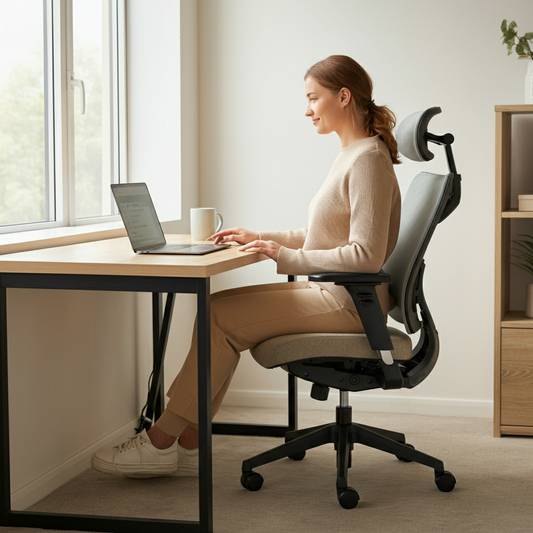Neck pain is one of the most common issues for people who spend long hours sitting at a desk. While it’s often attributed to stress or poor posture, your office chair could be the real culprit. An improperly designed or poorly adjusted chair can lead to strain on your neck, shoulders, and upper back, affecting both your comfort and productivity.
This guide explores the signs that your office chair may be contributing to your neck pain and provides actionable solutions to fix the problem. Additionally, we’ll highlight ergonomic options like Lundia’s supportive office chairs, designed to help you work in comfort and maintain proper posture.
How an Office Chair Can Cause Neck Pain
Sitting for prolonged periods in a subpar chair can result in poor posture, which directly impacts the neck and shoulders. Here’s how it happens:
Poor Lumbar Support
When the lower back lacks proper support, your spine compensates by rounding forward, ultimately causing your head and neck to strain as they try to remain upright.
Incorrect Chair Height
If your chair is too high or too low, you’re forced to hold your neck and shoulders in unnatural positions to see your computer screen, leading to strain.
Lack of Armrest Support
Without proper armrest support, your shoulders bear the weight of your arms, which can create tension in your neck muscles and upper back.
Non-Adjustable Features
Chairs without height or tilt adjustments fail to provide proper alignment and flexibility, forcing you into static positions that strain your neck over time.
Signs Your Chair is Causing Neck Pain
It’s not always easy to pinpoint whether your office chair is the reason for your discomfort. Here are the key signs to watch for:
- Persistent Neck Stiffness: A dull ache or stiffness that worsens after long workdays.
- Tension Headaches: Pain at the base of your skull caused by tight neck muscles.
- Shoulder Tension: Elevated or hunched shoulders while typing or using a mouse.
- Discomfort with Arm Movement: A lack of arm support can make simple movements cause strain.
- Difficulty in Maintaining Posture: Consistent slouching or the need to frequently shift your position.
If you’re experiencing any of these symptoms, it might be time to assess whether your chair is the root of the issue.
Solutions to Prevent and Relieve Neck Pain
The good news? You don’t have to live with this discomfort. These actionable solutions can make a world of difference in your daily comfort while working.
1. Adjust Your Chair Height
Proper chair height ensures your neck aligns naturally while you’re working. Your eyes should be level with the top third of your computer screen, preventing the need to tilt your head up or down.
How to Do It:
- Adjust the chair so your feet rest flat on the floor, with your knees bent at a 90-degree angle.
- Align your desk and monitor height to avoid unnecessary neck strain.
Chairs like Lundia’s ErgoMesh Task Chair come with adjustable seat height, ensuring you can easily find the ideal setting for your workspace.
2. Use Proper Lumbar Support
A chair with strong lumbar support encourages the natural S-shape of your spine, reducing strain on the upper back and neck.
How to Do It:
- Position the lumbar support cushion so it fits snugly into the curve of your lower back.
- Avoid leaning too far forward or backward—your back should stay in contact with the chair’s backrest.
The PostureMax Office Chair from Lundia is an excellent choice, featuring adjustable lumbar support for a tailored fit.
3. Ensure Armrests Are at the Correct Height
Armrests reduce pressure on your shoulders and neck by supporting your arms while typing or using a mouse.
How to Do It:
- Adjust the armrests so your elbows rest comfortably at a 90-degree angle.
- Check that your shoulders are relaxed, not elevated or hunched.
Lundia’s ergonomic chairs, like the ErgoActive Mesh Chair, include multifunctional adjustable armrests to suit different desk heights and tasks.
4. Tilt Your Backrest
A slight recline in your backrest can help distribute your weight evenly and relieve neck tension.
How to Do It:
- Set your chair’s tilt to an angle of 100–110 degrees for proper spine alignment.
- Use the recline function periodically to relieve static pressure on your lower back and neck.
The Classic Comfort Chair by Lundia incorporates a recline feature, allowing you to adjust your position without losing support.
5. Choose a High-Quality Ergonomic Chair
If your current chair lacks adjustability or support, consider upgrading to an ergonomic office chair designed to meet your specific needs.
Features to Look For:
- Height and depth adjustments
- Breathable materials for comfort during extended periods of use
- Contoured lumbar support
- Adjustable armrests and tilt/recline functions
Lundia’s extensive collection of ergonomic chairs offers a range of styles and features tailored to promote proper posture and lasting comfort.
Additional Tips for Neck Pain Prevention
While upgrading your chair and making adjustments are key steps, these additional tips can further enhance your neck health:
- Take Regular Breaks: Stand up and stretch every 30–60 minutes to release tension.
- Monitor Positioning: Position your screen at eye level and about an arm’s length away.
- Keyboard and Mouse Placement: Keep them within easy reach to avoid excessive arm stretching.
- Strengthen Neck Muscles: Simple exercises like neck rolls and stretches can build strength and relieve tension.
Why Lundia Ergonomic Chairs Are the Solution
With over 40 years of expertise, Lundia has built a reputation for creating ergonomic furniture that doesn’t compromise on quality or style. Their chairs are designed to support health and productivity with features specifically targeted to reduce and prevent discomfort.
From adjustable office chairs to breathable comfortable task chairs, Lundia products cater to a variety of needs and budgets. Browse their collection today at Lundia Ergonomic Chairs and take the first step toward a pain-free workspace.
Final Thoughts
Neck pain caused by your office chair is completely preventable with the right adjustments and equipment. By ensuring proper chair height, adjusting lumbar support, and using armrests correctly, you can significantly reduce discomfort and protect your spine.
Explore Lundia’s range of supportive chairs to upgrade your workstation and enjoy the long-term benefits of better posture and comfort. Your neck—and your productivity—will thank you.




